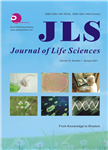Development Trends and Evaluation of Egbe Reservoir Water Nutrient Status in Ekiti State, Nigeria
Development Trends and Evaluation of Egbe Reservoir Water Nutrient Status in Ekiti State, Nigeria作者机构:Department of Zoology University of Ado Ekiti Ekiti State 0234 Nigeria Department of Zoology' University of lbadan lbadan Oyo State 0234 Nigeria
出 版 物:《Journal of Life Sciences》 (生命科学(英文版))
年 卷 期:2010年第4卷第1期
页 面:7-16页
学科分类:083002[工学-环境工程] 0830[工学-环境科学与工程(可授工学、理学、农学学位)] 07[理学] 08[工学] 0815[工学-水利工程] 0713[理学-生态学]
主 题:Physico-chemical parameters development trends nutrients Egbe reservoir.
摘 要:A study about some physicochemical parameters of Egbe reservoir was carried out from September 2005 to December 2006. The parameters include mean temperature, pH, conductivity, alkalinity, TSS, TDS, DO and BOD which have values of 28.7±0.9 ℃ ; 8.3±0.3; 831±172.5 μS/cm; 165.4±18.3 mg/L; 0.06±0.1 mg/L; 0.4±0.6 mg/L; 7.8±2.4 mg/L and 5.2±1.6mg/L, respectively. Temperature and pH were measured in the field using mercury-in-glass thermometer calibrated in degrees Celsius and pH meter, respectively. TSS and TDS were measured by grayimetric methods, while alkalinity was measured titrimetrically and DO and BOD were measured by Winkler's method. For the nutrients, nitrate was measured color±metrically, phosphate by Stannous Chloride method and sulphate by turbidimetric method. Mean concentration of nitrate, phosphate, and sulphate were 15.6±8.6 rag/L; 42.5±19.4 mg/L and 72.3±14.7 mg/L respectively. Nowadays, eutrophication of natural waters is one of the most significant causes of deterioration of water quality, and nitrates and phosphates are probably the key nutrients in controlling the growth of aquatic plants. Though the mean concentration of nitrates and phosphates in the reservoir water were within the acceptable limit, yet their concentrations in some locations of reservoir were high enough to encourage the growth of aquatic macrophytes which would increase productivities. Hence, it is necessary to check their further increase, and periodic monitoring and preventive measures must be adopted to save the reservoir from eutrophication.



